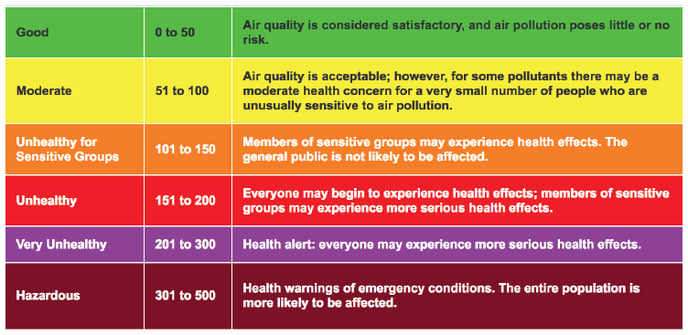PocketLab Air can measure Air Quality Index. Learn about AQI here.
Background Information
The Air Quality Index (AQI) is a scale for reporting the level of pollution in the ambient air in a specific location over a certain time period. The AQI helps people understand the health risks of the air they are breathing. A lower AQI number indicates less pollution and healthier air; a higher AQI number indicates more pollution and a higher risk of adverse health effects. AQI is calculated differently depending on the agency that measures and reports the data. For example, the United States Environmental Protection Agency (EPA) uses an AQI scale from 0 to 500, and the Canadian Air Quality Health Index uses a scale from 1 to 10. For the U.S. EPA scale, the values 0 to 500 correspond to 6 health levels.

pollutants:
- Ozone (O3)
- Particulate Matter (PM2.5 and PM10)
- Carbon Monoxide (CO)
- Sulfur Dioxide (SO2)
- Nitrogen Oxides (NO and NO2)
- AQI is based on the unhealthiest level of the five
pollutants. For example, if ozone is at an “Unhealthy”
level of 180 and the other pollutants are at a “Good”
level of 50 or below, the AQI will be equal to 180. - The pollutant levels are averaged over a time period of
1 to 24 hours. - If a measurement device cannot measure all five
pollutants, the AQI is calculated just from the
pollutants that can be measured.
How does the sensor work?
PocketLab Air calculates the AQI based on the U.S. EPA scale of 0 to 500. The AQI is calculated from particulate matter (PM2.5 and PM10) and ozone measurements. Carbon dioxide is not a pollutant measured for AQI. On the app display, the instantaneous AQI measurement
and a 10-minute running average are displayed. When you turn on PocketLab Air and start collecting data, the sensors may take up to 10 minutes to warm up and provide an accurate measurement. If you use PocketLab Air immediately after removing it from somewhere with lint or dust, the device will take some time to circulate ambient air through the sensors and provide an accurate measurement.
